Shove It
The shove-It is an extremely addictive and fun aerial maneuver with the sailor suspended directly over a flattened sail. Matt Pritchard invented the move around 1991 and I guess the move was named because you are shoving the rig horizontal into the wind. A very difficult move to learn that depends on total commitment to the move and the unique feel of approaching the wave and throwing yourself out over the sail and toward the nose of the board. I was hell-bent on learning this move one summer because I loved to watch Brad Drummond toss this move. I am not proud to say it took me 2 solid months of practice to learn. It's all about getting the feeling for this move and then you have it for endless days of pleasure.
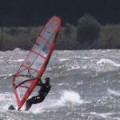

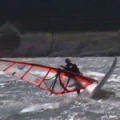
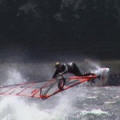
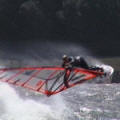

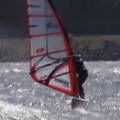

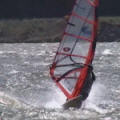
Rider: Royn Bartholdi
Steps
 1)
Look for a nice smooth and sloping wave. At first, choose a wave not too steep. Charge on a beam reach just downwind of the wave to gather tons of speed.
1)
Look for a nice smooth and sloping wave. At first, choose a wave not too steep. Charge on a beam reach just downwind of the wave to gather tons of speed.  2)
Unhook and rake the sail back, slightly over-sheeting, to cause the board to head upwind into the meat of the wave. You are also getting on your heels.
2)
Unhook and rake the sail back, slightly over-sheeting, to cause the board to head upwind into the meat of the wave. You are also getting on your heels.  3)
As you near the top of the wave, lay the sail down (horizontal to the water) and back like a lay down jibe but keep your body rigid (especially your upper body) and leaning out and forward over the wave.
3)
As you near the top of the wave, lay the sail down (horizontal to the water) and back like a lay down jibe but keep your body rigid (especially your upper body) and leaning out and forward over the wave.  4)
As you kick off the wave then throw your whole body forward and out over the sail. This should be exaggerated and you must totally commit. The front arm should be extended and stiff. This is the critical section of the maneuver that will make or break the move.
4)
As you kick off the wave then throw your whole body forward and out over the sail. This should be exaggerated and you must totally commit. The front arm should be extended and stiff. This is the critical section of the maneuver that will make or break the move.  5)
While laid-out (horizontal) over the sail, push out with your back hand like you are trying to stick the clew into the water. This will present more sail area to the apparent wind and is usually the only action necessary at this point. However, if the wind is weak or you are moving slow then you may have to pull-up with your front hand and turn your upper body windward.
5)
While laid-out (horizontal) over the sail, push out with your back hand like you are trying to stick the clew into the water. This will present more sail area to the apparent wind and is usually the only action necessary at this point. However, if the wind is weak or you are moving slow then you may have to pull-up with your front hand and turn your upper body windward.  6)
The apparent wind will cause your rig to swing vertical. It's all about the apparent wind and you learning to trust this phenomenon. When you trust then you commit.
6)
The apparent wind will cause your rig to swing vertical. It's all about the apparent wind and you learning to trust this phenomenon. When you trust then you commit.  7)
Eventually you will return vertical and preferably landing off the wind so you can plane out of this move. Start off with tail landings but then learn to land nose first.
7)
Eventually you will return vertical and preferably landing off the wind so you can plane out of this move. Start off with tail landings but then learn to land nose first.  8)
The landing is smooth like a good jump.
8)
The landing is smooth like a good jump.  9)
Sheet in and sail away Was that fun or what?
9)
Sheet in and sail away Was that fun or what? Videos
Loading the player ...
Here I am performing a Shove-It at Arlington Oregon on the starboard tack. Notice how I perform this maneuver across the wind but I am still able to upright the rig because I push out with the clew hand while simultaneously shoving the sail forward to the nose of the board. This action exposes the sail to the apparent wind and positions your body for the recovery (when you get upright again). The harder and faster you shove the faster you are pushed upright.
Helpful Skills
- Strong on-shore wind conditions...
- Good jumping capability...
- Courage to throw yourself over sail... Laydown-Jibe helpful.
Tips
- Either you make or crash this move. If you can pull out of this move without sticking it then you are not committing yourself over the sail and are simply a poser.
- Over powered conditions makes this move easier.
- You can head slightly upwind for this move to gain benefit from the actual wind.
- If you're getting backwinded then: (1) You are heading too far into the wind for the conditions. With experience, you will learn to judge your angle to the wave and the wind. (2) You are pushing too hard on the backhand.
- You pull up with the front hand to expose the sail more to the apparent wind and not to yank the sail up vertical.
- Ideally, the wind should push you up vertical and not the pulling of the front hand; this usually runs contra to our initial desire to pull the sail vertical until we learn to trust the wind.
- Initially, to learn the mechanics of this maneuver and minimize your risk, try doing mini-shove-its by picking small swell and heading way into the wind, throwing yourself over the sail. Graduate to bigger waves when you feel you're making progress.
Ideas
- Tweaking this move by twisting your body and throwing your back foot above your head is totally sick and requires great experience and control.
- Try the one hander by bringing the backhand forward on the boom and releasing the front hand mid-air.
- Land in a Vulcan.
- Land in a Cheese-Roll.
- What about a double pump?
- Grab the board.
- What happens if you try to head directly into the wind?
All Contents Copyright © 2008-2025 Royn Bartholdi. All Rights Reserved